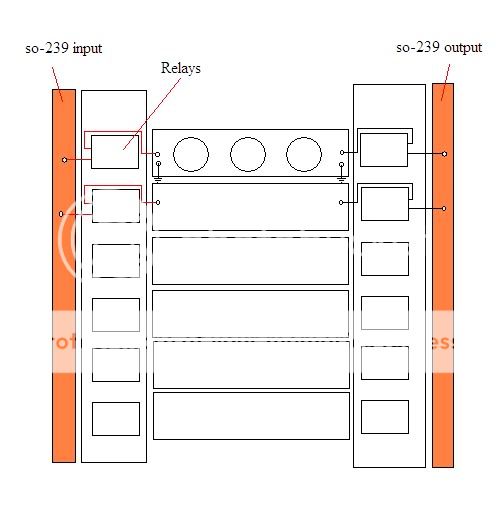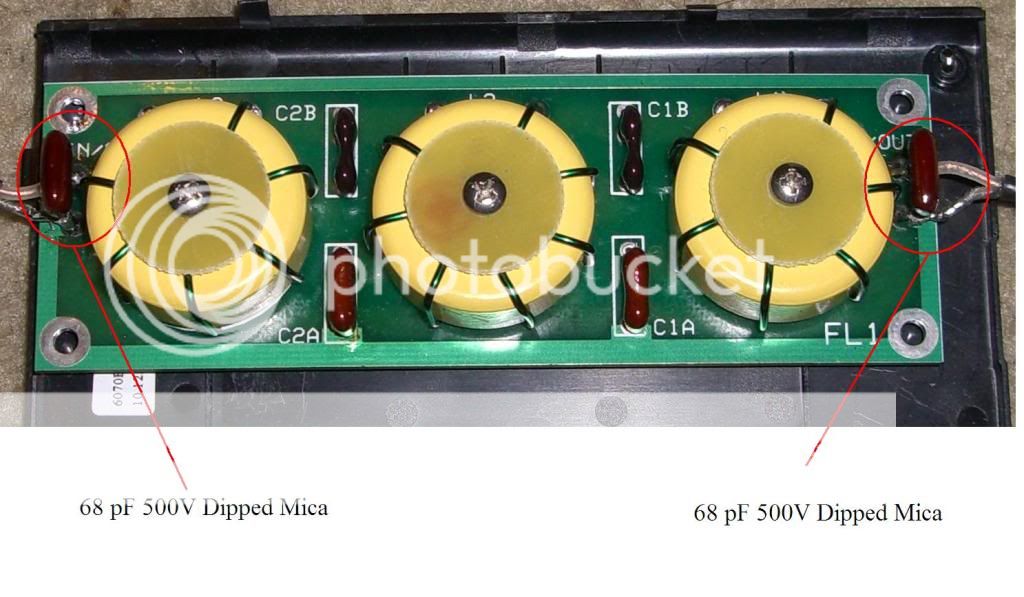I just wanted to share a recent experience and a major improvement I discovered while building this set of low-pass filters from CCI. In the base configuration (L-input 5-pole) the input impedance varied a good amount over the bands that the filter will be used on, resulting in a highly variable input SWR. Here I'll be discussing the 10m filter since it's been the main subject of my experimentation. The input SWR of the 10m filter as constructed in accordance with the supplied instructions was perfectly usable from 28.0MHz to 29.3MHz, but the power handling capability needed to be derated at the bandwidth edges as the input SWR approached 1.8:1, indicating an impedance mismatch which seemed to overheat one of the capacitors (in the photo below it's the lower right-hand mica cap in the central group of 4) to the point of burning out. In it's original configuration the maximum continuous (100% duty for 10+ minutes) power I could pass through the filter was around 75W without eventual damage. These filters are rated to 300W PEP, which is actually conservative since the toroids and capacitors should allow up to 500W PEP if optimized properly, so by my logic they should be able to handle at least 120W continuously. I felt that there was some need for improvement, so I modeled the circuit in ELSIE so that I could play around with various configurations and view their responses and parameters.
Here's a graph of the cutoff (red) and vswr (blue) of the 10m filter as supplied by CCI (based on a schematic from an ARRL text):
The swr curve has some nice low points that kind of roughly correspond to the bands that the filter will be used on (10/12m) but they also peak above 2.0 at certain points across the bandwidth. In real-world usage these peaks fall closer to the bands of operation than I'd like, resulting in somewhat high SWR at the edges of these bands. As I'm looking for peak performance across the widest possible bandwidth I felt improvement was possible and necessary.
A primary interest of mine was to keep the core configuration of the filter intact, so I didn't want to alter the cap values or the inductor values of the original configuration. That left the option of adding more components.. by adding 2 more capacitors I ultimately ended up with a 7-pole filter with much better input impedance values and sharper cutoff.. both good things! Plus the finished mod was about as easy as it gets.
As can be seen in the original schematic the main capacitance consists of 118pF shunted to ground. This is comprised of a 100pF cap in parallel with an 18pF cap on the board itself:
I found that adding two more capacitors with values roughly half of the originally installed capacitance (118/2, or ~68pF in this case since I had quite a few 68pF caps on hand) at the input and output of the filter resulted in better performance across the bandwidth with much less loss, resulting in full power-handling capability (easily handles 120W+ continuous without major heating):
Here's the curves for the improved 7-pole filter. You can see that the input vswr no longer peaks nearly as high near the intended bands of operation while the cutoff is sharper. The real-world performance mimicked the software plots almost exactly:
Here's the finished filter. The added caps are simply soldered across the input and output connection points:
This logic can be applied to all of the filters. I found that adding 2 more capacitance poles with values of roughly half of the originally installed capacitance values made for a much more user-friendly and better performing filter regardless of the intended band of operation. I'm certainly no expert, just a hobbyist, so I hope that this information works for others with similar results.







